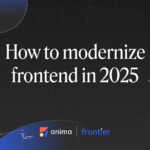Modernize Frontend in 2025: Future-proof your web and app development5 min read
Reading Time: 4 minutesModernize frontend in 2025: Future-proofing your web and app development
Front-end development is crucial for companies aiming to deliver high-performance, scalable, and secure web apps. As development grows more sophisticated, scaling the development process and modernizing frontend architecture becomes essential. This guide explores effective strategies to modernize frontend applications in 2025, showcasing the best tools and techniques, including how Anima and Frontier by Anima can streamline the process.
Why you should modernize your frontend infrastructure in 2025
Many companies are stuck with outdated frontend frameworks and architectures. Staying updated is essential to remain competitive in today’s digital landscape.
-
Enhanced user experience: Newer technologies reduce loading times and improve responsiveness, meeting user expectations for speed and functionality.
-
Streamlined team collaboration: Modern tools enable multiple teams to work independently on frontend components, reducing bottlenecks and accelerating development.
-
Cost reduction: Modern frontend architectures, such as Microfrontends, lower maintenance costs and allow gradual migration, minimizing risks.
-
Improved security: Up-to-date frontend frameworks and tools offer better access control and faster response to vulnerabilities.
If your company is still operating with outdated frontend technology, now is the time to act. This article outlines proven strategies to modernize your frontend in 2025.
Top strategies to modernize your frontend in 2025
-
Adopt component-based architecture
Component-based architectures form the foundation of scalable frontend applications. In 2025, reusability is key. Creating modular components that can be reused across multiple projects reduces redundancy and ensures design consistency. Companies should invest in design system components based on headless frameworks and open-source design system frameworks. Designers can create reusable components that stay synchronized with their code counterparts.
Frontier by Anima plays a critical role here, enabling developers to convert design files directly into production-ready code. This bridges the gap between design and development, speeding up development and onboarding new developers into the design system.
-
Adopt a design system
Speak the same language as the product design team. Use a set of components and design tokens (colors, fonts, spacing, etc.) as a common language across the organization. Design systems are often built on open-source UI libraries like MUI, Antd, or ShadCN.
Anima’s tools facilitate design system adoption and developer onboarding with AI-powered design-to-code solutions, integrating smoothly into the company’s codebase.
-
Leverage edge rendering and server-side rendering (SSR)
For fast, interactive web applications, edge rendering and SSR are essential. By using solutions like Vercel’s Edge Functions or Cloudflare Workers, you can bring content closer to users, improving load times and user experience on a global scale. React with Next.js has become the industry standard for seamlessly combining server and client-side components, leveraging SSR to optimize performance. While new frameworks like Qwik and SolidJS offer unique hydration techniques for faster interactivity, React and Next.js remain the best choice due to their robust community support, maturity, and ecosystem integrations. As you modernize your frontend in 2025, we recommend React and Next.js to fully utilize SSR and Edge Rendering and deliver the best experience possible
-
Shift towards microfrontends for scalability
Microfrontends allow teams to break down a monolithic frontend into smaller, independently deployable parts, simplifying application scalability. Large front-end applications benefit from enabling large teams to build and deploy with standard interfaces between different code segments.
Frontier by Anima supports the transition to Microfrontends by offering efficient workflows for designing and coding isolated components. Teams can develop components independently, aligning seamlessly with a microfrontend architecture.
-
Implement DevSecOps for security and efficiency
In 2025, DevSecOps is integral to frontend modernization. Integrating security into the development and deployment pipeline ensures quick detection and mitigation of potential threats. Tools like Snyk or SonarQube are common in DevSecOps for managing security.
Although Frontier by Anima doesn’t directly integrate with CI/CD pipelines, it provides strong organization tools to keep design and development workflows consistent, enabling secure and efficient code handling across teams.
-
Automate your CI/CD workflow, use telemetry, and experiment
Modernizing the frontend requires frequent updates and deployments, making CI/CD essential. These frameworks test and validate each release, allowing companies to iterate quickly. Continuous testing ensures new updates don’t break production, while features can be developed behind Feature Toggles and Experiments using systems like Optimizly or LaunchDarkly.
Ongoing experimentation and monitoring help measure user response to changes. Start with main business flows for test coverage, and expand gradually.
How Anima and Frontier by Anima support frontend modernization in 2025
Anima and Frontier by Anima offer key functionalities to address common challenges in frontend modernization:
Streamlined design-to-code workflow
Frontier by Anima converts design files into clean, production-ready code, bridging the gap between design and development. This accelerates development, reduces errors, and ensures design consistency across frontend components.
Centralized component library
Anima’s centralized repository for reusable components enables teams to access and maintain up-to-date features, supporting efficient, component-based development and avoiding redundant work.
Isolation and compartmentalization
Frontier by Anima lets teams focus on specific frontend segments, allowing each component to be developed and tested independently, enhancing scalability.
Wishing you a modern and productive 2025
To effectively modernize frontend applications in 2025, companies need a well-planned approach, strong frameworks, and tools supporting scalable, secure, and high-performing architectures. Consider the following:
- Choose solid frameworks: React’s flexibility enables breaking down monolithic frontends into independently deployable microfrontends. When paired with Next.js, MUI, and ShadCN, it offers both flexibility and performance.
- Prioritize security with DevSecOps: Integrate security-focused tools early in the modernization process.
- Foster collaboration across teams: Tools like Frontier by Anima facilitate smooth transitions from design to code, ensuring consistency and reducing errors.
As technology and user expectations continue to evolve, modernizing your frontend in 2025 is essential for staying competitive. By leveraging component-based architectures, edge rendering, microfrontends, and tools like Anima and Frontier by Anima, companies can build robust, efficient, and scalable applications designed for the future.


 Figma
Figma Adobe XD
Adobe XD Sketch
Sketch Blog
Blog


